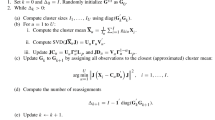Abstract
Generalized bilinear models are presented for the statistical analysis of two-way arrays. These models combine bilinear models and generalized linear modeling, and yield a family of models that includes many existing models, as well as suggest other potentially useful ones. This approach both unifies and extends models for two-way arrays, including the ability to treat response and explanatory variables differently in the models, and the incorporation of external information about the variables directly into the analysis. A unifying framework for the generalized bilinear models is provided by considering four particular cases which have been proposed and used in the existing statistical literature. A three-step procedure is proposed to analyze data sets by generalized bilinear models. Two data sets of different nature are analyzed.
Similar content being viewed by others
References
Aitchison, J. (1983). Principal component analysis of compositional data.Biometrika, 70(1), 57–65.
Aitchison, J. (1986).The analysis of compositional data. NY: Chapman and Hall.
Andersen, E. B. (1980).Discrete statistical models with social science applications. Amsterdam: North Holland.
Baccini, A., Caussinus, H., & Falguerolles, A. (1991). Comment (to Goodman's paper).Journal of the American Statistical Association, 86, 1115–1117.
Becker, M. P. (1990a). Quasisymmetric models for the analysis of square contingency tables.Journal of the Royal Statistical Society, Series B., 52, 369–378.
Becker, M. P. (1990b). Maximum likelihood estimation of theRC(M) association model.Applied Statistics, 39, 152–167.
Beecher, H. K. (1959). Measurement of subjective responses. Oxford, England: Oxford University Press.
Benzécri, J. P. (1976).L'Analyse des Données: Tome 2, L'Analyse des Correspondances [Data Analysis: 2nd Volume, Correspondence Analysis]. Paris: Dunod.
Bishop, Y. V. (1969). Full contingency tables, logits, and split contingency tables.Biometrics, 25, 119–128.
Coombs, C. H. (1964).A theory of data. New York: Wiley.
Darroch, J. N., & Mosimann, J. E. (1985). Canonical and principal components of shape.Biometrika, 72, 241–252.
Gabriel, K. R. (1971). The biplot graphical display of matrices with application to principal component analysis.Biometrika, 58, 453–462.
Gabriel, K. R. (1978). Least squares approximation of matrices by additive and multiplicative models.Journal of Royal Statistical Society, Series B, 40, 186–196.
Gollob, H. F. (1968). A statistical model which combines features of factor analytic and analysis of variance techniques.Psychometrika, 33, 73–115.
Goodman, L. A. (1979). Simple models for the analysis of association in cross-classifications having ordered categories.Journal of the American Statistical Association, 74, 537–552.
Goodman, L. A. (1981). Association models and canonical correlation in the analysis of cross-classifications having ordered categories.Journal of the American Statistical Association, 76, 320–334.
Goodman, L. A. (1985). The analysis of cross-classified data having ordered and/or unordered categories: Association models, correlation models, and asymmetry models for contingency tables with or without missing entries.Annals of Statistics, 13, 10–69.
Goodman, L. A. (1986). Some useful extensions of the usual correspondence analysis approach and the usual log-linear models approach in the analysis of contingency tables.International Statistical Review, 54, 243–309.
Goodman, L. A. (1991). Measures, models, and graphical displays in the analysis of cross-classified data (with discussion).Journal of the American Statistical Association, 86, 1085–1138.
Gower, J. C. (1966). Some distance properties of latent roots and vector methods used in multivariate analysis.Biometrika, 53, 325–388.
Gower, J. C. (1989). Discussion of the paper by Van der Heijden, de Falguerolles and de Leeuw.Applied Statistics, 38, 275–276.
Greenacre, M. J. (1984).Theory and applications of correspondence analysis. Academic Press: N.Y.
Haberman, S. J. (1978).Analysis of qualitative data. New York: Academic Press.
Holland, P. W., & Thayer, D. T. (1983). Using modern statistical methods to improve the presentation of the annual summaries of GRE candidate background data (ETS Research Report, 83-8). Princeton, NJ: Educational Testing Service.
Kazmierczak, J. B. (1985a). Analyse logarithmique: deux exemples d'application [Logarithmic analysis: Two examples of application].La Revue de Statistique Appliquée, 33, 13–24.
Kazmierczak, J. B. (1985b). Une application du principe de Yule: l'analyse logarithmique [An application of Yule's principle: Logarithmic analysis]. In Diday et al. (Eds.), Proceedings of the fourth InternationalSymposium on Data Analysis and Informatics (pp. 393–403). Amsterdam: North Holland.
Kazmierczak, J. B. (1987). Sur l'usage d'un principe d'invariance pour aider au choix d'une métrique [The use of an invariance criterion for the choice of a metric].Statistique et Analyse des Données, 12, 37–57.
Lauro, N. C., & D'Ambra, L. (1984). L'analyse non symmetrique des correspondances [Nonsymmetrical correspondence analysis]. In Diday et al. (Eds.),Data Analysis and Informatics III (pp. 433–446). Amsterdam: North Holland.
Mandel, J. (1961). Non-additivity in two-way analysis of variance.Journal of the American Statistical Association, 56, 878–888.
Mandel, J. (1971). A new analysis of variance model for non-additive data.Technometrics, 13, 1–18.
McCullagh, P., & Nelder, J. A. (1989).Generalized Linear Models (2nd ed.). NY: Chapman and Hall.
Moolgavkar, S. H., Stevens, R. G., & Lee, J. A. H. (1979). Effect of age on incidence of breast cancer in females.Journal of the National Cancer Institute, 62, 493–501.
Nishisato, S. (1980).Analysis of categorical data: Dual scaling and its applications. Toronto: University of Toronto Press.
Nishisato, S., & Lawrence, D. R. (1989). Dual scaling of multiway data matrices: Several variants. In R. Coppi & S. Bolasco (Eds.),Multiway Data Analysis (pp. 317–326). Amsterdam: North Holland.
Pettitt, A. N. (1989). One degree of freedom for nonadditivity: Applications with generalized linear models.Biometrics, 45, 1153–1162.
Rao, C. R. (1964). The use and interpretation of principal components analysis in applied research.Sankhya A, 26, 239–358.
Rao, C. R. (1973).Linear statistical inference and its applications (2nd ed.). NY: Wiley and Sons.
Rice, J. A. (1988).Mathematical Statistics and Data Analysis. Pacific Grove, CA: Wadsworth & Brooks/Cole.
Takane, Y., & Shibayama, T. (1991). Principal component analysis with external information on both subjects and variables.Psychometrika, 56, 97–120.
Torgerson, W. S. (1958).Theory and methods of scaling. New York: Wiley.
Tukey, J. W. (1949). One degree of freedom for non-additivity.Biometrics, 5, 232–242.
Author information
Authors and Affiliations
Additional information
The author is very grateful to Shizuhiko Nishisato, the associate editor and the referees for their valuable comments, which resulted in a completely improved version of an earlier manuscript.
Rights and permissions
About this article
Cite this article
Choulakian, V. Generalized bilinear models. Psychometrika 61, 271–283 (1996). https://doi.org/10.1007/BF02294339
Received:
Revised:
Issue Date:
DOI: https://doi.org/10.1007/BF02294339




